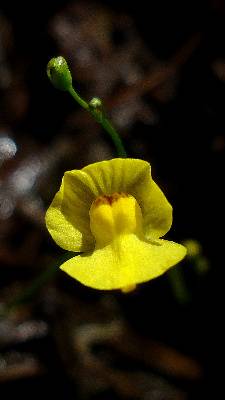The other half of The Carrot & The Stickle team, Laura Stein, also contributed to today’s article.
 This week, at my nerdy crew’s Biology and Beer night, we had a great discussion about science hype and the disconnect between studies and how they are reported. Our discussion centered around a paper published this month in Nature about the gloriously named bladderwort (pictured right), a carnivorous plant that, as it turns out, has one of the smallest plant genomes to ever be sequenced.
This week, at my nerdy crew’s Biology and Beer night, we had a great discussion about science hype and the disconnect between studies and how they are reported. Our discussion centered around a paper published this month in Nature about the gloriously named bladderwort (pictured right), a carnivorous plant that, as it turns out, has one of the smallest plant genomes to ever be sequenced.
First, a little bit of background as to why the genome of this little plant is so interesting. Within the DNA of all living organisms there are regions that don’t have a job, and these regions have been given the unflattering name of “junk” DNA. Junk DNA takes up a lot of space; in fact, 98% of the human genome does not contain code for any genes. As recently as ten years ago scientists could not figure out what this junk DNA was for. We now know that what was previously considered junk is actually very important to many of the molecular processes in complex organisms. Now the cool part: The authors of the Nature study found that the bladderwort genome is special because it is 97% coding, meaning that only 3% of its genome is junk. This is vastly different from most plant genomes, where around 60% of the DNA does not contain genes. The authors suggest within the abstract of the paper that “junk” DNA is not required for complex organisms. This is a new suggestion based on one genome; most genome scientists think that there is a reason the junk is there.
The Biology and Beer crew felt that the authors (there are 29 of them — it takes a village to sequence a genome) make a gross overstatement and oversimplification, and this sentiment is shared. However, the suggestion was picked up and run with in blogs and press releases across the web. Now that you are up to speed on the bladderwort genome, here are some of the press releases we found:
- “The newly sequenced genome of the carnivorous bladderwort contradicts the notion that vast quantities of noncoding DNA are crucial for complex life”
- “Flesh-Eating Plant Cleaned Junk From Its Minimalist Genome”
- “’Junk’ DNA Mystery Solved: It’s Not Needed”
 Calling this litter floater of a plant “flesh-eating” is a bit extreme. We aren’t talking Little Shop of Horrors; the bladderwort eats tiny animals within the water. You can see for yourself in this YouTube video. Even more critical, though: overstating results and insisting that one organism is evidence for a paradigm shift is actually detrimental to science. We see this all the time in pop culture concerning nutrition and fad diets. I even pointed it out in my article about coffee — many lines of evidence are necessary to test hypotheses. Overstating the implications of a study can lead to the public not taking science seriously. As scientists, we want to promote our research and we strive to make connections that are meaningful to the public; however, in doing so we run the risk of alienating our audience when the results are overturned with further experimentation. Tis a fine line to walk. In the end, the evolution of the bladderwort genome is cool enough without being overhyped.
Calling this litter floater of a plant “flesh-eating” is a bit extreme. We aren’t talking Little Shop of Horrors; the bladderwort eats tiny animals within the water. You can see for yourself in this YouTube video. Even more critical, though: overstating results and insisting that one organism is evidence for a paradigm shift is actually detrimental to science. We see this all the time in pop culture concerning nutrition and fad diets. I even pointed it out in my article about coffee — many lines of evidence are necessary to test hypotheses. Overstating the implications of a study can lead to the public not taking science seriously. As scientists, we want to promote our research and we strive to make connections that are meaningful to the public; however, in doing so we run the risk of alienating our audience when the results are overturned with further experimentation. Tis a fine line to walk. In the end, the evolution of the bladderwort genome is cool enough without being overhyped.
Feature image from Alterna2.
Photo of bladderwort by Alex Popovkin.








